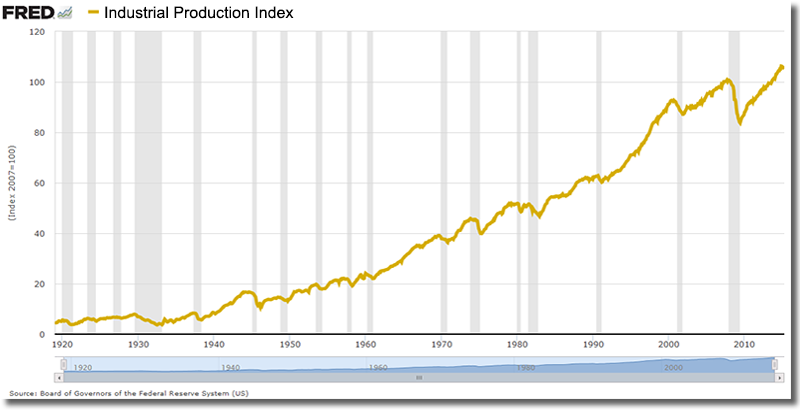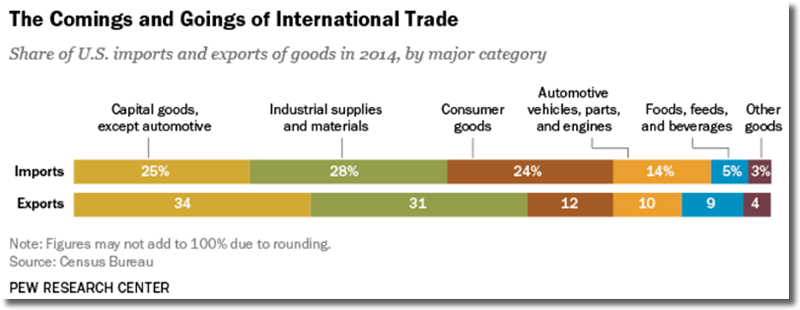Why Americans Are So Nostalgic About The Manufacturing Industry
The fate of American manufacturing is back in the headlines, thanks to the bipartisan slugfest going on over the Trans-Pacific Partnership, the massive trade deal that has become a source of conflict between President Obama and Democrats in Congress.
On Monday, Matt Yglesias did his Matt Yglesias thing, and pointed out that, contrary to a lot of narratives about the decline of U.S. manufacturing, the sector’s production is actually at an all-time high (see sidebar).
It may have declined as a share of the country’s overall economic production, but that’s just because other sectors like health care and education have gotten bigger in comparison - not because manufacturing has shrunk.
“One source of the misunderstanding,” Yglesias noted, “is that manufacturing jobs really have disappeared” - dropping from about a third of all jobs in the 1950s to a little under 10 percent today.
That’s mainly a story of growing automation and productivity gains; we can just make way more per worker now.
The biggest misunderstanding about trade and manufacturing, in 2 charts
One thing I consistently hear when I talk to people about trade or manufacturing is the idea that while the United States used to make lots of things, nowadays everything comes from China or Mexico or the like.
This is, however, not the case. Manufacturing has certainly declined as a share of the overall American economy, but US industrial production is higher than it’s ever been:

Source: St Louis Fed
One source of the misunderstanding is that manufacturing jobs really have disappeared. The growing use of automation in factories means that since the mid-1990s or so, output has managed to rise modestly even as employment has tumbled.
But another reason is revealed by this Pew chart of what America imports and exports, which shows basically that the United States imports a lot of stuff normal people buy and exports a lot of stuff normal people don’t buy:

Source: PewReseachCenter
Consumer goods and cars are two big things people buy, and both of them are things the US imports more of than we export.
Meanwhile, 65 percent of our exports are either capital goods or industrial supplies - in other words, machines and equipment that companies buy to conduct their businesses. Sometimes that’s something like a computer that might also be sold to a consumer. But more typically we are talking about products that aren’t sold in stores or marketed to normal people. You’ve probably never bought a Boeing 737, for example, and almost certainly never will. But airplanes are very expensive. The sale of a single new passenger jet contains as much value of industrial output as a truly tremendous pile of shoes or toys or other consumer goods.
The other source is more interesting: The U.S. still manufactures a lot of stuff, but most of it isn’t stuff average American consumers buy.
These days, we mostly make heavy industrial equipment, circuitry, aircraft, and other big and expensive goods and high-end products.
These also constitute more than two-thirds of the manufactured goods we export, while about half of the manufactured goods we import are things like cars, food, beverages, clothing, jewelry, electronics, and other consumer goods.
Like the proverbial blind man who grabs an elephant’s tail and assumes he’s laid hold of a snake, Americans see the parts of the manufacturing economy they have immediate experience with - how many jobs it provides, the stuff they buy - and assume U.S. manufacturing is in decline.
Now, just as a matter of common sense, it’s important to keep your data straight. So Yglesias is right to keep pointing out that manufacturing production is actually doing just fine in this country.
But allow me to put in a word in defense of the Americans who are grabbing an elephant’s tail and think it’s a snake.
The vast majority of voters - and the vast majority of politicians who try to translate what they hear from those voters into digestible political narratives - are not economists. They don’t think in strictly “economic” terms. When they worry that manufacturing is declining, it’s probably not because they think it’s harming GDP growth, or because they think there’s a better mix of industrial sector strengths, or some other macroeconomic claim.
What they’re arguably saying is something like: “This aspect of the economy was really important to the livelihoods of my family, friends, and community. And now it’s dying.” They’re making something closer to an argument about the health of the social fabric.
As I’ve said before, I think we in the wonkosphere tend to fall into the trap of thinking of the economy as some sort of free-floating phenomenon that exists to serve its own ends. We note that manufacturing output is not in decline, that productivity and GDP growth seem to be okay, and then we go on with our day. But that’s incomplete.
The economy is here to serve people; to make their lives better; to do useful things for us and to give us something useful to do.
Admittedly, on the “do useful things for us” front, the changes in manufacturing in the last 40 years are pretty defensible. A lot of manufacturing went overseas because goods could be produced more cheaply there. So we get imports for a lower cost, which improves our standard of living. People in other, less developed nations get new jobs, which (assuming labor standards are up to par, which they often aren’t) improves theirs. A win-win, theoretically speaking.
Same goes for rising automation: How could it possibly be a bad thing that we’re able to create more wealth with less toil?
But the 1950s economy was also a delicately balanced ecosystem. The U.S. economy was relatively insular. Americans traded with other Americans, and bought their products from other Americans. And American firms generally competed with other American firms.
Along with some robust government intervention and pressure from a still-powerful union movement, this created an environment where wages were good, health and pension benefits were plentiful, and job security was high. Manufacturing, as a third of employment, was a key part of that.
And then globalization happened, and all that went away. But that wasn’t just some unfortunate event that was out of everyone’s hands, like a meteor strike. The arrival of globalization gave certain interests and centers of power in our society the wedge and hammer they needed to break up the old arrangement. Unions became far weaker, business owners and management got much freer hands, and worker bargaining power collapsed.
The economic benefits of cheaper imported goods weren’t broadly shared, because policymakers used globalization to put lower-class Americans in competition with foreign workers, but not upper-class Americans. Roughly the same outcome came from the benefits of innovation: Instead of the additional productivity leading to a drop in working hours for everyone, it led to a significantly bigger chunk of the overall income produced by the economy going into the pockets of the people at its very top echelons.
That result wasn’t inevitable. Other Western countries also endured globalization, but managed to keep their levels of inequality lower - both before and after you count taxes and transfer programs. They also often took much more proactive approaches to the partnership between government and labor unions, resulting in friendlier labor policies and robust and surviving union membership.
Another lesson is probably that, with its more limited government and smaller safety net, the 1950s prosperity was a lot more precarious than it appeared, and the U.S. was always poorly positioned to endure globalization.
Ultimately, what people miss about manufacturing is the role it played in ensuring broadly shared prosperity. If we’d found some sort of alternative economic strategy for producing those same results, it’s unlikely voters or politicians would be nostalgically lamenting any decline.
Source: The Week
Related: The Myth of America’s Manufacturing Renaissance














